Internship stories
Emma Edling
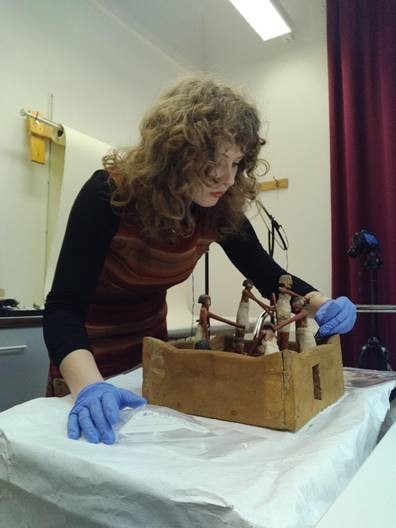
Hello Emma Edling! You are studying a master's in humanities - Art History, Uppsala University. What does an art historian do at the historical collections?
My interest in art and art history stems from a love for history! What appeals to me is how visual expressions reflect human culture through time, and art history today encompasses a broad understanding of what visual culture is and what fits within the concept of art. Many of the objects in the historical collections I believe have a place in art historical research.
What does a typical workday look like?
Unique to my experience is partly that my internship period spans a whole semester and that I actively get to take part in the move back to Gustavianum and the design of the new permanent exhibition. Tasks include writing object labels, photographing and digitizing the objects destined for the museum, packing them, and assisting with the actual move, among other things. Being on site gives me the opportunity to see all the thought processes and the practical work behind the New Gustavianum.
What have you learned?
The varied tasks have allowed me to gather a lot of knowledge and experience, from handling objects to getting close to things in a completely different way with the camera lens. Primarily, I have learned about the work behind the various steps required to realize an exhibition. There is so much that happens behind the scenes that visitors may not see.
Tell us about the structure and content of your thesis?
My master's thesis, 'Drop Dead Gorg(on)eous: A Multimodal Discourse Analysis of the Contemporary Medusa Tattoo,' was presented in early 2024 and examines the phenomenon of the contemporary 'Medusa tattoo' that has gained attention on the TikTok platform as a symbol of surviving sexual abuse and has subsequently been used as a tool for digital feminist activism. The study looks at the emergence, function, and potential of the Medusa tattoo and consists of a multimodal discourse analysis followed by the application of a selected number of theoretical frameworks by Hans Belting, Michael Baxandall, Roland Barthes, and Hélène Cixous.
Sara Saleh
Hello Sara Saleh! You are a student at Uppsala University and have done an internship at Gustavianum and the historical collections during your studies. How did that come about?
I have always been a driven person who wants to make connections, learn new things and gain experience to build my career. I had, already, visited the collection store, and the opportunity to do a internship there was extremely exciting for me.
What has a typical workday looked like for you during the internship?
A typical day consisted of a lot of detailed work. I was responsible for examining Betsel 1 from Valsgärde grave 7, where I documented and preserved all find numbers and their relationships. Of course, my working day included socializing and having a good time with all the fantastic colleagues, researchers and interns!
Have you learned anything new?
I have gained a broad understanding of antiquarian practice and how to correctly seek information about the finds you are handling, as well as ensure that they are stored correctly. I got to see the other side of the coin of archaeological practice, and the important work that goes on after an excavation. The relationship to the objects you handle is completely unique.

Lina Pettersson Schweitzer
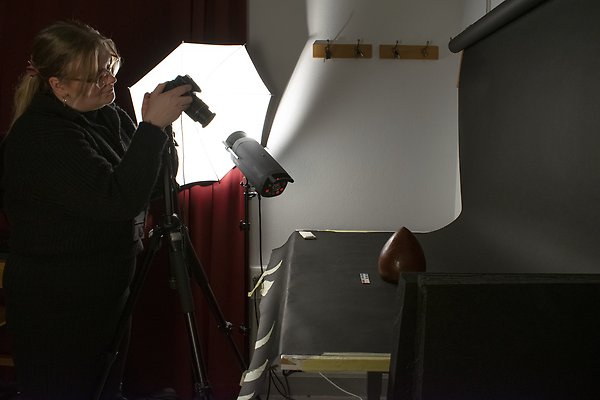
Hello Lina Pettersson Schweitzer! You are a student at Uppsala University and have done an internship at Gustavianum and the historical collections during your studies. How did that come about?
I am pursuing a master's degree in early modern history but have a background in archaeology and art history, so I longed to work with objects again. Therefore, an internship at the historical collections was a perfect fit for me.
What has a typical workday looked like for you during the internship?
I have had the opportunity to try various tasks during the internship, but primarily, I have been in the museum's photo studio. There, I have photographed objects from the collections, and these object photos will be used in the database, for publications, or displayed in Gustavianum's new exhibitions.
What have you learned?
I have gained a lot of new knowledge from the internship, including how to handle objects correctly and safely. A significant personal achievement was learning how to edit out distracting spots from photos in Photoshop. Overall, it has been instructive to get an overview of what daily work behind the scenes at a museum can look like.
Magdalena Johansson Hammar
Education program: Master's program in digital Art History, Uppsala University.
What have you learned?
A lot! I have written object and exhibition texts, inventoried and researched objects in the collections. A large part of my internship has been spent researching one of the university's 17th century portraits, which it now turns out is not at all the person who has been thought for almost 200 years, but another much more famous person! I carry with me a lesson that it is not always possible to trust what is written in the literature. Be curious and dare to dig into the sources!
What has been the most fun about the internship?
To really "sink your teeth" into something real and work with things that will reach out to others. And of course to get so close to the objects and see all the hard work required to manage the university's fine collections.
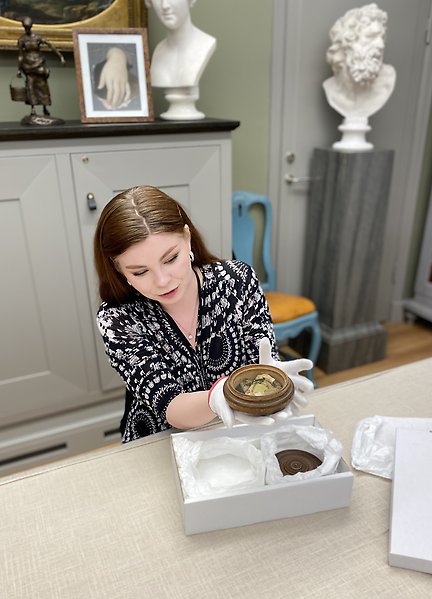
Mimmi Nihlén
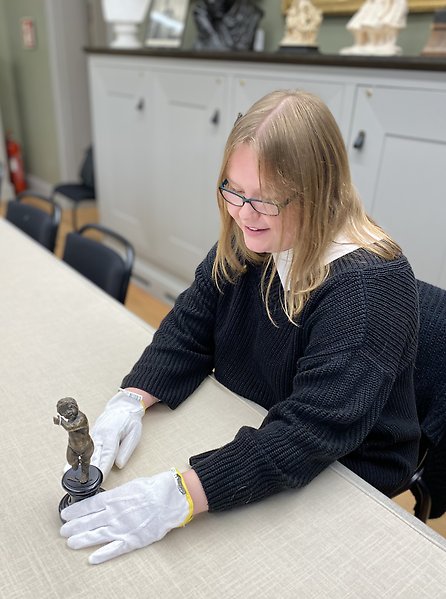
Education program: The master's program in humanities with a specialization in Art History, Uppsala University.
What have you learned?
Where to start? Above all, I have learned how work at an art collection can look and be divided, with everything from inventorying deployed art and photographing paintings to writing object labels and dealing with conservation issues. It is an organization with important tasks, and as an intern I have appreciated being able to take part in many different parts of the collection's activities. An instructive, but difficult, process has been writing object labels. Sticking to a specific number of characters to describe an art object with a museum visitor in mind is not an easy task, but something you learn a lot from. In addition, the proximity to objects from the Augsburg cabinet and paintings from the collection has contributed to new interests and knowledge.
What has been the most fun about the internship?
To work so close to objects and works of art. As a student, the focus is often on theoretical learning and writing text, which is also important and fun, but being able to touch, move and examine paintings in a museum context has been incredibly exciting and educational! It has also been fun to see a museum's operations from the inside, especially in connection with Gustavianum's new opening next year and in contact with other museums regarding loans, for example. The workplace itself has also been fun to be around - lots of great laughs and encouragement of curiosity thanks to great supervisors!
Eirik Is De Visser
Education: I am a second-year Research Master student following the pre-modern history track at the University of Groningen (the Netherlands). I have been a research fellow at several American research institutes, including the Center of Historical Studies at the University of Pennsylvania. Furthermore, I have been in the coin trade since 2011, having worked at several coin firms in the Netherlands and the United States.
What have you learned?
The most important lesson I have learned is so far is that the digitization of a coin collection is a long and slow process. It takes a great deal of time and patience to explain everything about the artifacts in adequate detail. It also requires a certain finesse to describe the importance of a particular coin in a way that is meaningful to an audience who are not numismatists. Sometimes those attempts to enthuse the general public about coins are successful, and sometimes they are not.
What has been the most fun about the internship?
For me, the best thing about the internship has been spending time in the vault, sifting through the crates of coins to look for rare objects or ones with great stories. It feels like treasure hunting: you never know what to expect or what you are going to find.

Kevin Frigård

Education program: Master's program in humanities with a focus on archeology and ancient culture and social life, Uppsala University.
What have you learned?
I have learned to handle archaeological material with the whole process from just excavated right through to photographing the material. How the material should be treated in order to be preserved for future generations. The guidelines for how to photograph and how to enter objects into a database.
What has been the most fun about the internship?
Getting to know Oscar, Emilia and Tova where our card game rounds during lunch have been relaxing. The chance to talk to visiting researchers and ask related questions regarding archaeological problems. Having the opportunity to be able to do a job without being questioned about everything you do, where the freedom to be believed by your bosses that the job will be done in the end.
Tova Lindblad
Education program: Master's program in humanities with a focus on archeology and ancient culture and social life, Uppsala University.
What have you learned?
I have learned a lot from having my internship at Gustavianum. It is a different thing to actually get close to archaeological objects than to just read about them theoretically. You get a different understanding of the objects and can get close to them and discover new things all the time.
What has been the most fun about the internship?
Everything at the internship was fun and interesting, and a great benefit has been that there was such a good atmosphere between us interns and the other employees. One of the funniest days at the internship was when we were quite unprepared to take off and photograph an Egyptian sarcophagus. That whole day was very fun and challenging, and as we shot, more and more new and exciting things emerged.
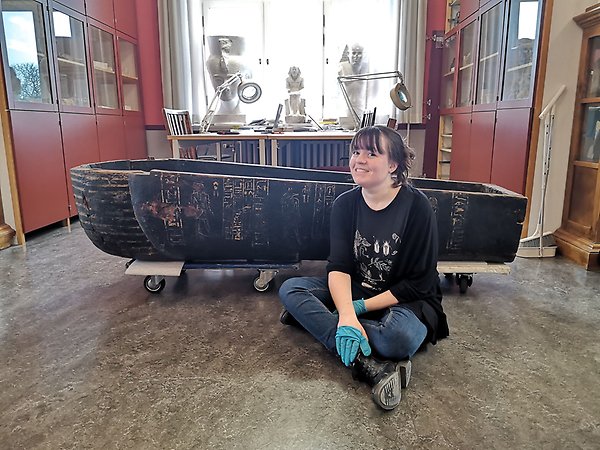
Emilia Wall
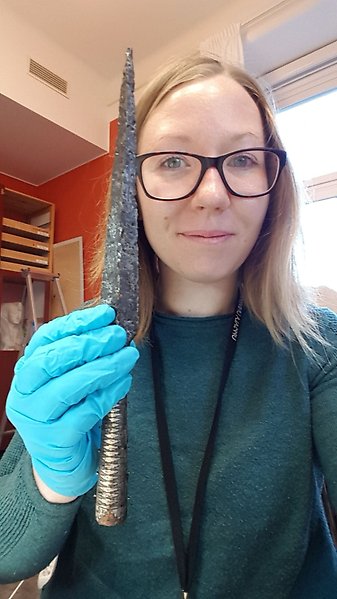
Education program: Master's program in humanities with a focus on archeology and ancient culture and social life, Uppsala Univetsity.
What have you learned?
During my internship at the Gustavianum, I have learned so much more about how work with archaeological material can be done. Learning how the preservation of archaeological objects is done has been incredibly rewarding, it has given me a better understanding of how important it is to be able to preserve material for the future. The work has been varied, it has included everything from Egyptian to Viking age material, which has made it even more rewarding than I thought.
What has been the most fun about the internship?
The most fun about the internship has been how varied it has been. It has been so rewarding and interesting to learn more about Valsgärde and the various boat graves. However, the most fun has been photographing and examining an Egyptian sarcophagus and looking for mummy heads.
Oscar Olsson
Education program: Master's program in humanities with a focus on archeology and ancient culture and social life, Uppsala University.
What have you learned?
What the daily work can look like "behind the scenes" at a museum. Everything that it means to make a database around the objects when we create a knowledge bank around them. Something that really stood out to me was the new discoveries you can make with objects when you study them more closely with a camera lens, the new details that emerge and the importance of being able to illuminate this to gain a greater understanding of the time the objects represent.
What has been the most fun about the internship?
That new unexpected tasks could appear with objects from all kinds of time periods that were outside of the normal work. Above all, it has also been fun to work with historical material together with other students and researchers from other disciplines. Different from when you have a shorter group work in other studies, the internship is very fun because you work closer to your fellow students for a longer time and have a lot of fun as a group.
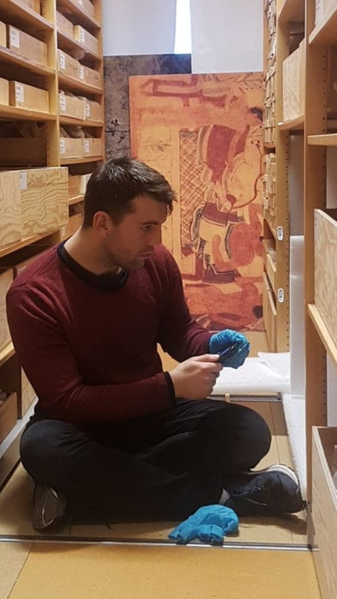
Ellen Ivarsson and Lina Sjöblom

Education program: Master's program in archeology and ancient history, with specialization in archeology and osteology respectively, Uppsala University.
What have you learned?
What we learned the most from during and after our internship was how the archaeological work looks like after the fieldwork is finished. By having access to the documentation from Valsgärde boat grave 5, which was excavated during the first half of the 20th century, we have understood the importance of clear documentation and structured finding management. In addition, it has been cool to see how older excavation material is in some cases reworked and reinterpreted into a digital era with documentation in a database, photography of finds and how important it is to pay attention to details, both in words and in pictures. It was also very fun and educational to help take down the Valsgärde exhibition before the upcoming renovation of the museum. We have had the chance to meet other researchers and build up our network. Now we know what we want to do in the future!
What has been the most fun about the internship?
All! But the most valuable thing has been that we both became so involved in the project with Valsgärde, and that our supervisor has involved us and encouraged our curiosity. Since day one, we have been treated as employees rather than interns, and this has forced us to take responsibility and work independently. The work has been very hands-on, and that suits us!
Cajsa Olausson
Education program: Master's program in humanities with focus on ancient culture and social life, Uppsala University.
What have you learned?
It is hard to mention everything I have learned as there is so much! I have mainly been able to study the Nubian collection, which consists of vases, leather goods and bones, and I have learned to handle and digitize the material.
What has been the most fun during the internship?
The most fun has been being able to take part in the unpacking of the Mediterranean and Nile Valley exhibition. It was great fun handling and studying objects so closely and I now know what a mummy smells like!

